Natural Padparadscha Sapphire: A Comprehensive Exploration
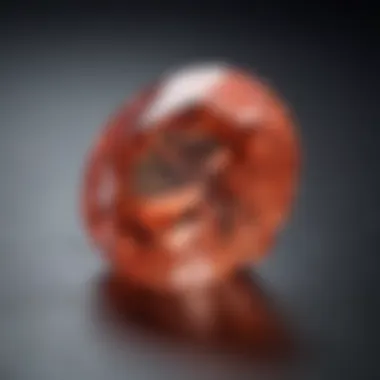
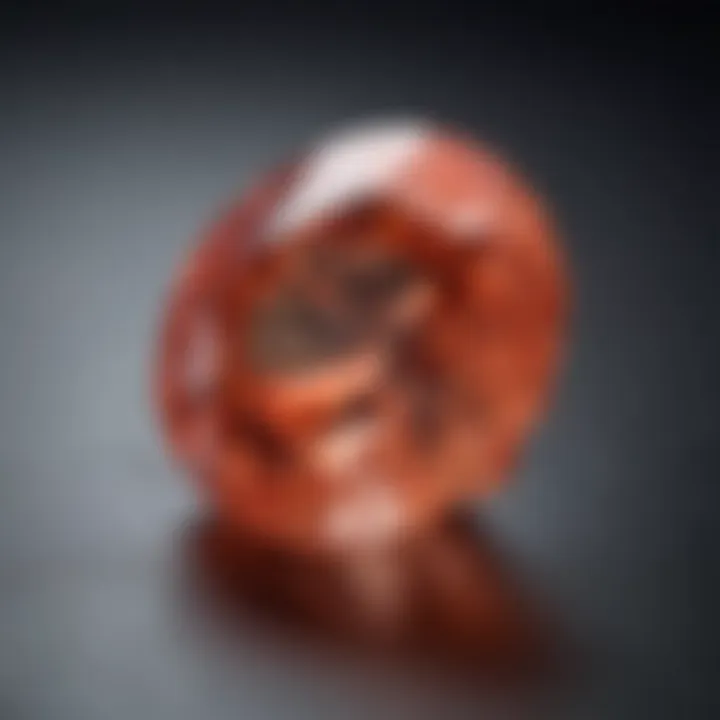
Intro
Natural padparadscha sapphire stands out as a fascinating gemstone that has captured the attention of collectors and jewelry enthusiasts alike. Its distinct color, falling between pink and orange, sets it apart from other sapphires. This section aims to provide an initial understanding of its characteristics and significance, leading to deeper exploration in subsequent sections.
Gemstone Overview
Definition of Gemstones
Gemstones are minerals or organic materials that are cut, polished, and used for jewelry and ornamentation. They possess beauty, durability, and rarity, which contributes to their lasting appeal. Natural padparadscha sapphire qualifies as a gemstone due to its splendid appearance and unique attributes. Its value is influenced not only by its beauty but also by its geological formation which occurs naturally within the Earth.
Classification of Gemstones
In the world of gemstones, classification is crucial for understanding their types and origins. Gemstones can be classified into two main categories:
- Precious Gemstones: These include diamonds, rubies, emeralds, and sapphires, known for their exceptional quality and value.
- Semi-Precious Gemstones: This category encompasses a wider range of stones, often less valuable, such as amethyst and garnet.
Natural padparadscha sapphires fall under the category of precious gemstones due to their rarity and exquisite qualities.
Historical Significance
Origins of Gemstone Use
The use of gemstones dates back thousands of years. Historically, gemstones have served numerous purposes, from symbolizing power and wealth to being used as talismans. Natural padparadscha sapphire, due to its unique color and rarity, has found its way into the elite echelons of society. Ancient cultures valued sapphires for their beauty and believed they possessed protective properties.
Cultural Insights: Gemstones in Ancient Civilizations
Across various ancient civilizations, gemstones were integral to spiritual and cultural practices.
- In Ancient India: Sapphires, including padparadscha, were associated with planetary influences and were used in astrological practices.
- In Ancient Egypt: Gemstones were buried with the dead to ensure safe passage to the afterlife.
- In Ancient Greece: Sapphires were linked to wisdom and were worn by philosophers.
The historical significance of padparadscha sapphire adds layers of meaning to its allure, emphasizing its role beyond mere aesthetics. This context enhances the appreciation of these captivating stones as we continue to unravel their complexities in the following sections.
Prelude to Padparadscha Sapphire
Understanding padparadscha sapphire is essential for those with an interest in gemstones. This type of sapphire is not only unique because of its vibrant color range but also because of its rarity. This introduction provides a foundation for exploring the various aspects of padparadscha sapphire, from its formation to its market significance. The information within this section sets the stage for appreciating why this gemstone captures the attention of gem enthusiasts, collectors, and jewelers.
Definition and Characteristics
Padparadscha sapphire is distinguished by its seductive blend of pink and orange hues. This unique color spectrum results from the presence of trace elements such as chromium and iron during the gem's formation. Unlike other sapphires, which can be categorized more easily by color, padparadscha exhibits a complex interplay of shades. Accordingly, the color often appears to change under different lighting conditions, adding to its charm.
A notable characteristic of padparadscha sapphires is their high clarity. Many samples feature minimal inclusions, providing them with a vibrant and appealing look. Moreover, the cutting style affects how the color is displayed, with well-crafted stones refracting light excellently. The overall quality of padparadscha sapphires is determined by these factors, which include color clarity, cut, and carat weight.
Significance in the Gemstone World
In the world of gemstones, padparadscha sapphire holds a special place. Its rarity makes it particularly sought after, attracting attention from both collectors and designers. Historically, these gemstones were often reserved for royalty and high-ranking officials, symbolizing power and prestige. Today, their significance continues to grow as more individuals uncover their beauty and elegance.
Furthermore, padparadscha sapphires are not commonly found in large sizes, which adds to their allure. As a result, they command high prices in the marketplace. The increasing demand from jewelry designers for unique stones has also helped elevate the status of padparadscha sapphire.
"The padparadscha sapphire is more than just a gemstone; it is an emblem of elegance that transcends its physical beauty."
This section serves as a gateway to deeper insights into its geological formation, quality criteria, market potential, and many other dimensions.
Geological Formation of Natural Padparadscha Sapphire
Understanding the geological formation of natural padparadscha sapphire is critical for appreciating its rarity and beauty. This section explores how these gemstones are created, where they are sourced, and the implications these factors have on their market value and desirability. To comprehend the significance of padparadscha sapphire fully, one must delve into its formation process and the unique natural conditions required to produce such exquisite stones.
Formation Process
The formation of natural padparadscha sapphire occurs over millions of years deep within the Earth’s crust. These sapphires are composed primarily of corundum, a mineral that also includes aluminum and oxygen. The unique coloration of padparadscha sapphires—characterized by a delicate blend of orange and pink—takes shape under specific geological conditions.
During the crystallization process, extraordinarily high temperatures and pressures play crucial roles. This process is influenced by the presence of trace elements such as chromium and iron that induce the distinctive coloring. Unlike other sapphires formed under varied conditions, padparadscha sapphires require a fine balance in their environment to achieve their unique hues. Notably, this color is not merely a result of chemical composition but also the interaction with geological environments and thermal activities over time.
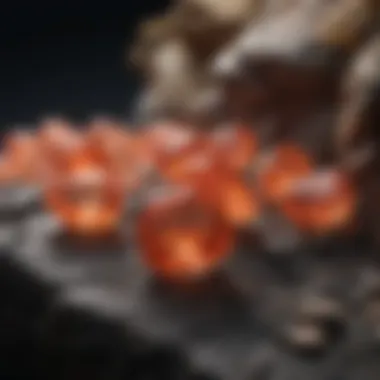
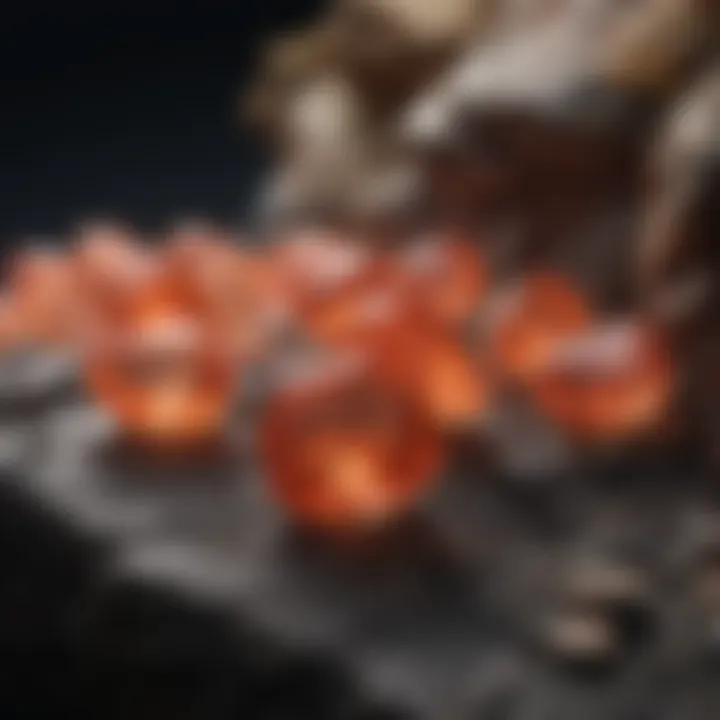
Geologists believe that many natural padparadscha sapphires form in metamorphic rocks. They often reside in alluvial deposits, where they are deposited by river systems after being eroded from their original geological formations. Overall, the intricate natural processes culminating in the formation of these gemstones underscore their uniqueness and value.
Locations of Natural Sources
Natural padparadscha sapphires are primarily found in a few key regions, each with distinct geological features that contribute to the quality of the gemstones. These locations include:
- Sri Lanka: Regarded as the birthplace of padparadscha sapphires, Sri Lanka’s gem-bearing gravels are renowned for producing some of the finest stones. The country's age and geological conditions foster ideal environments for sapphire formation.
- Madagascar: The discovery of padparadscha in Madagascar has gained significant attention in recent years. The vibrant colors and clarity of stones from this region offer exciting competition to traditional sources.
- Myanmar (Burma): Historically a significant source, Myanmar has produced high-quality padparadscha sapphires with unique color characteristics. However, factors affecting political and mining regulations may impact availability.
- Tanzania: Emerging as a new source, mineral deposits in Tanzania are being explored for their potential. Early findings suggest promising varieties of padparadscha sapphires.
These locations reveal how geological factors—such as temperature, pressure, and mineral composition—converge to create the natural beauty of padparadscha sapphire. Recognizing the areas where these gemstones originate helps enthusiasts and investors understand their rarity and desirability in the market.
"Natural padparadscha sapphires exemplify geological rarity, making them a prized possession for collectors and jewelry designers."
In summary, the geological formation of padparadscha sapphire is an intricate dance of natural processes, environmental factors, and sourcing locations. Understanding these elements provides insight into the overall appreciation and valuation of these exceptional gemstones.
Color Variations and Quality Criteria
Understanding the color variations and quality criteria of natural padparadscha sapphire is important due to its impact on the gemstone's value and desirability. The unique color spectrum, quality grading, and how these factors influence market perception are essential for collectors, gem enthusiasts, and jewelry designers. This section elaborates on these elements so readers can make informed decisions regarding padparadscha sapphire, whether for personal investment or design purposes.
Understanding the Unique Color Spectrum
The color spectrum of padparadscha sapphire is unlike any other gemstone. This sapphire showcases a blend of pink and orange tones, a combination that defines its uniqueness. The saturation of these colors can vary significantly, influencing both the appearance and market value. Natural padparadscha sapphires can exhibit an array of shades ranging from soft pastels to vibrant hues, which allows for a broad spectrum of options for gemstone enthusiasts.
Quality Grading Factors
Color Saturation
Color saturation plays a crucial role in assessing the quality of padparadscha sapphire. A deeply saturated color often indicates a higher value, as it enhances the gem's visual impact. The essential characteristic of color saturation is its brightness and intensity. Choosing sapphires with vibrant saturation can make a piece of jewelry more visually appealing, drawing the eye and enhancing overall elegance. However, overly intense colors can sometimes detract from the charm, as they might appear unnatural.
Clarity and Inclusions
Clarity and inclusions refer to the internal characteristics that can impact the overall beauty of the gemstone. A high clarity padparadscha sapphire is free from significant flaws, which enhances its desirability and value in the market. The key characteristic here is transparency, with fewer inclusions leading to better light performance. However, certain inclusions may also tell a story of the gemstone's formation. In fact, some collectors appreciate the unique fingerprints left by nature, preferring stones with a bit of character.
Cut and Shape
Cut and shape are paramount in determining how light interacts with the padparadscha sapphire. The facets of a well-cut gemstone reflect light beautifully, which enhances its overall brilliance. A precise cut can highlight the unique colors of the sapphire, making it more desirable. The most common shapes include oval, cushion, and round. However, personal preference varies; some may favor less traditional designs, which can add a unique twist to jewelry pieces. A carefully considered cut can elevate the overall appearance, making it a crucial aspect for both buyers and designers.
"The combination of color saturation, clarity, and cut is what defines the true beauty of natural padparadscha sapphire. Understanding these factors leads to smarter investment and design choices."
Market Demand and Investment Potential
The market demand for natural padparadscha sapphire has steadily increased over the years. Investors and collectors are drawn to its unique qualities and rarity. This section discusses the implications of market trends and investment potential regarding this exceptional gemstone.
Current Market Trends
Currently, natural padparadscha sapphire is considered a luxury item. Its distinctive colors and scarcity contribute to its popularity among gemstone enthusiasts. The online market has opened avenues for international buyers, leading to significant price fluctuations. Buyers are more inclined to purchase gemstones with certified authenticity, enhancing consumer confidence in the market.
Factors Influencing Value
Several elements impact the value of natural padparadscha sapphire. They include:
Rarity
Rarity is a key factor in determining the value of padparadscha sapphire. This gemstone is not commonly found, making it more coveted. A unique attribute of its rarity is its limited geographical sources, primarily Sri Lanka and parts of Madagascar. Collectors find its rarity attractive because it ensures exclusivity in ownership. However, scarcity can also lead to unpredictable pricing, which can be a challenge for potential investors.
Historical Significance
Historical significance adds depth to the gemstone’s value. Padparadscha sapphires have a longstanding association with royalty and spirituality in various cultures. This history contributes to the allure and mystique of the stone. Its background makes it a popular choice for collectors interested in gemstones with rich narratives. Yet, not every collector may appreciate historical context, which can limit its appeal.
Global Demand
Global demand impacts the pricing and accessibility of padparadscha sapphires. Emerging markets, particularly in Asia, have seen an uptick in luxury spending. This increasing interest heightens competition among buyers, impacting demand positively. It is beneficial for investors looking to acquire valued pieces. However, the volatility of global markets can also bring uncertainties.
Collectors should monitor trends and market dynamics as these can significantly influence investment choices.
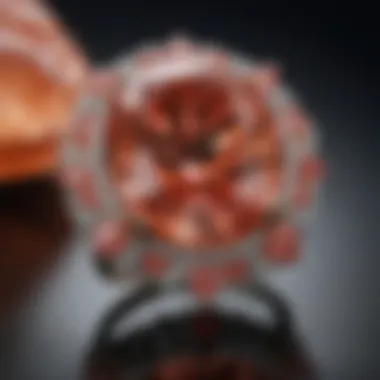
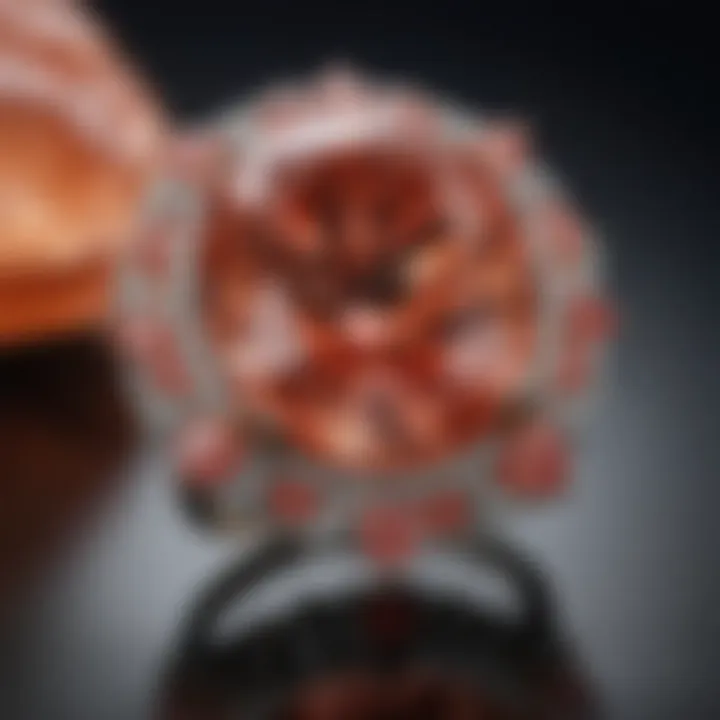
Identifying Natural Padparadscha Sapphire
Identifying natural padparadscha sapphire is crucial for both enthusiasts and collectors. The ability to distinguish genuine gemstones from imitations or synthetics greatly impacts their value and desirability. As a distinctive variety of sapphire, padparadscha possesses specific traits that experts use to verify its authenticity.
Understanding these identification processes grants buyers confidence in their acquisitions and assures investment reliability. Moreover, this knowledge enhances appreciation of the padparadscha's unique attributes, from its rare color spectrum to its cultural significance.
Appraisal by Experts
Expert appraisal serves as a cornerstone for identifying natural padparadscha sapphires. Only trained gemologists can accurately assess the characteristics that differentiate genuine stones from lesser counterparts. These specialists utilize their knowledge of color, clarity, and inclusions to authenticate each gem. Key dimensions they examine include hue variations and overall luster.
Having an expert appraisal ensures that collectors are informed before making significant purchases. It prevents buyers from engaging in fraudulent transactions, as padparadscha sapphires can be quite valuable, often fetching high prices in the market.
Lab Testing Techniques
Lab testing techniques are pivotal for authenticity verification. Among the most significant techniques are spectroscopy and refractive index measurement. Each method offers insights into the gemstone’s composition and properties, reinforcing its authenticity.
Spectroscopy
Spectroscopy is a crucial analytical technique in identifying natural padparadscha sapphire. It examines the light absorption properties of a gemstone. By analyzing these patterns, experts can determine whether a sapphire is natural or synthetic. This method highlights the distinct absorption features unique to natural gemstones.
One key characteristic of spectroscopy is its precision; even subtle differences in composition can be detected. This makes it a beneficial choice for gem identification. However, interpreting results requires specialized knowledge and experience, which can be a disadvantage for casual buyers without access to expert analysis.
Refractive Index Measurement
Refractive index measurement provides valuable data regarding the optical properties of padparadscha sapphire. Each gemstone has its unique refractive index that can help identify it. This technique is relatively straightforward, as it relies on observing how light bends when entering the stone.
The key advantage of this method lies in its accessibility. Even non-experts can utilize basic refractometers to obtain readings. Nevertheless, it is crucial to combine this measurement with other identification techniques for maximum accuracy. Solely relying on refractive index might yield misleading results if not corroborated by additional tests.
Identifying natural padparadscha sapphires involves expert appraisal and advanced lab techniques, ensuring the authenticity and value of these remarkable gemstones.
Caring for Padparadscha Sapphire
Caring for padparadscha sapphire is an essential aspect for owners and enthusiasts alike. This distinctive gemstone not only possesses immense beauty but also requires special consideration to maintain its luster and integrity over time. Given its rarity and the premium values associated with it, proper care ensures that the stone retains its vibrancy and does not sustain any damage.
Cleaning Methods
Cleaning padparadscha sapphire needs to be done cautiously. Regular maintenance helps in keeping the stone spotless, while also preventing potential issues resulting from dirt accumulation. Here are some recommended cleaning methods:
- Soft Cloth Wipe: Use a soft, lint-free cloth daily to remove oils and dust. This helps to maintain shine without risking scratches.
- Mild Soap Solution: Mix a few drops of mild soap with warm water. Soak a soft brush in the solution and gently scrub the sapphire with soft strokes. Rinse thoroughly and dry it with a cloth.
- Avoid Harsh Chemicals: Chemicals can harm the stone; do not use harsh cleaners, as they can scratch or dull the surface. Also, be careful with ultrasonic cleaners as they might not be safe for this delicate stone.
Storage Recommendations
Proper storage is vital for the longevity of padparadscha sapphire. When it is not worn, placing it in a secure and appropriate environment can prevent scratches and damage. Here are some recommended practices:
- Separate Storage: Store padparadscha sapphires separately from other gemstones and jewelry pieces. This prevents scratches that can occur when they come in contact.
- Soft Pouches or Dedicated Boxes: Use cloth pouches or dedicated jewelry boxes with compartments to keep the sapphire secure and cushioned.
- Avoid Humidity: It is advisable to store padparadscha sapphire in a dry place, as excessive moisture can lead to issues over time.
Proper care extends the life of padparadscha sapphire, making it not just a beautiful object but a lasting treasure.
These cleaning and storage methods address the specific needs of padparadscha sapphire, thus enhancing its appeal and maintaining its condition. By adopting these practices, owners can ensure their gemstones remain as captivating as the day they acquired them.
Padparadscha Sapphire in Jewelry Design
Padparadscha sapphire holds a unique position in the realm of gemstones, particularly in jewelry design. The distinct peach-pink hues of these sapphires allow them to stand out as a focal point in various jewelry pieces. Their rarity, combined with stunning visual appeal, makes them ideal for collectors and designers alike. This section will delve into popular jewelry styles that feature padparadscha sapphire while exploring customization options that highlight its beauty.
Popular Jewelry Styles
Rings
Rings featuring padparadscha sapphire are among the most sought after. Their specific aspect lies in their ability to transform a simple metallic band into a luxurious statement piece. The key characteristic of these rings is the versatility of design. Whether set in yellow gold or white gold, the warm tones of padparadscha complement a variety of metals. This adaptability enhances their popularity.
A unique feature of padparadscha rings is their ability to symbolize love and uniqueness, making them favorable for engagement rings. However, the softer nature of these stones, when compared to diamonds, means they require careful handling and may not be suitable for everyday wear.
Necklaces
Necklaces incorporating padparadscha sapphire add elegance to any attire. The specific aspect of necklaces is their ability to frame the face, drawing attention to the wearer's features. A key characteristic is the ability to layer these necklaces with other gemstones, creating a multi-dimensional effect in design.
One unique feature is that padparadscha can be set as a pendant or as a part of a more complex design. These pieces are popular but can be slightly more delicate. The consideration here is finding a balance in the bead or link design that supports the sapphire while providing it visibility.
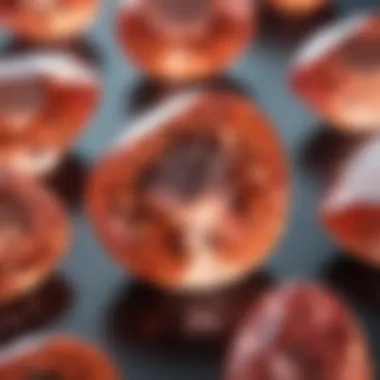
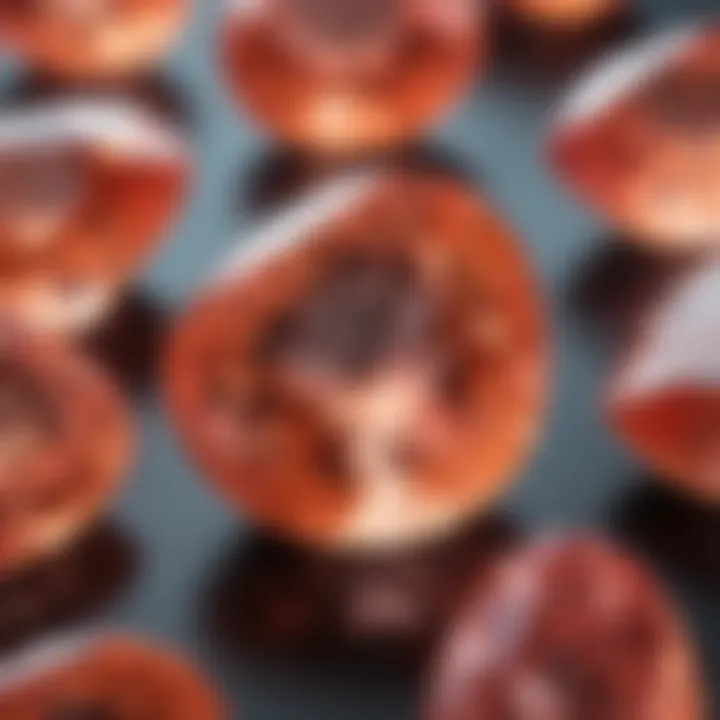
Bracelets
Bracelets that include padparadscha sapphire are not as prevalent as rings and necklaces, yet they present an elegant alternative for gemstone lovers. The specific aspect of bracelets is their capacity to showcase multiple stones in a single piece, which can highlight the varying shades of padparadscha.
The key characteristic of these bracelets is they often include a range of smaller sapphires alongside larger central stones, creating a rich visual impact. However, securing these stones effectively is crucial, as bracelets can be more prone to bumps and wear compared to rings and necklaces.
Customization Options
Customization options for padparadscha sapphire jewelry are extensive, allowing individuals to create unique pieces that reflect personal style. Choosing the type of metal, design style, and accompanying stones can create a truly one-of-a-kind masterpiece. Many jewelers offer services to incorporate specific designs or engravings that align with personal narratives, enhancing the sentimental value of the piece.
When customizing jewelry, consideration should be given to the wearability and protection of the stones. The finesse in designing with padparadscha sapphires can result in exquisite pieces that are not only beautiful but also durable when crafted with appropriate settings.
Padparadscha sapphire's role in jewelry design showcases its versatility and importance, bridging historical significance with contemporary style.
Cultural Significance of Padparadscha Sapphire
The cultural significance of padparadscha sapphire is an essential aspect of its allure. This unique gemstone has not only captivated gem enthusiasts but also holds a profound place in various cultures throughout history. Its rare color and beauty have made it a symbol of love, balance, and harmony. Understanding the historical and modern interpretations of this gem can enrich appreciation for its value and uniqueness.
Historical Uses
Historically, padparadscha sapphire has been revered in many cultures for its distinctive hues of pink and orange. In ancient Sri Lanka, where it is predominantly found, these sapphires were often used in royal adornments. Kings and queens treasured them, believing they brought prosperity and protection. The stone's rarity made it a status symbol among the elite. For example, in some South Asian traditions, padparadscha sapphire was thought to channel positive energy and ward off negativity. It was not just an object of beauty; it was woven into rituals and ceremonies. This historical significance imbues the gemstone with a deeper essence that goes beyond mere aesthetics.
Modern Symbolism
In contemporary society, the padparadscha sapphire continues to represent love and commitment. It is gaining popularity as an alternative engagement stone, particularly for couples looking to break from tradition. The gem's unique color spectrum represents individuality in a relationship. Furthermore, it's associated with emotional balance and serenity, making it an appeal for those interested in healing crystals and holistic practices.
Today, many jewelry designers incorporate padparadscha into their collections, appealing to those who value not only the gemstone’s beauty but also its historic significance. Its integration into modern jewelry signifies a blend of tradition and contemporary tastes, showing adaptability in purpose and meaning.
The padparadscha sapphire is not only valued for its stunning appearance but also for the rich cultural narratives that surround it.
Overall, both historical and modern interpretations of padparadscha sapphire underline its rarity and profundity. The cultural significance of this gemstone only accentuates its desirability, making it a sought-after piece among collectors and designers alike.
Comparison with Other Sapphires
The comparison with other sapphires is essential to understand the unique position of natural padparadscha sapphire in the gemstone market. Examining these differences allows enthusiasts and collectors to appreciate the padparadscha’s distinct qualities. It also helps in the valuation process, influencing buying decisions and investment strategies. Understanding these contrasts supports a deeper insight into what makes padparadscha sapphires desirable.
Differences from Blue Sapphire
Natural padparadscha sapphires exhibit vivid colors that are markedly different from the deep blue hues of traditional blue sapphires. The padparadscha displays a blend of pink and orange, resembling the tones of a sunset. The visual difference is striking and can significantly influence personal preference among collectors.
Several factors distinguish the padparadscha from blue sapphire:
- Color Spectrum: The mingling of pink and orange in padparadscha sapphires creates a unique color profile that is absent in blue sapphires.
- Market Value: While both sapphires can command high prices, the rarity of natural padparadscha often results in greater market demand and higher value.
- Symbolism and Association: Blue sapphires frequently symbolize nobility and wisdom, while padparadscha sapphires carry a more eclectic significance often associated with tranquility and balance.
Padparadscha vs. Fancy Color Sapphires
Fancy color sapphires encompass a wide variety of colors, including yellow, green, and pink, among others. When contrasted with these stones, padparadscha sapphires stand out due to their specific blend of colors and rarity. Both padparadscha and fancy color sapphires may share some common ground in terms of price and exclusivity; however, their distinctions in hue and market positioning are noteworthy.
Key points of comparison include:
- Color Combinations: Unlike many fancy color sapphires, which can sometimes appear too vibrant or saturated, padparadscha's unique color blend is softer and more muted.
- Identification Challenges: Identifying a natural padparadscha among fancy colored sapphires is challenging. Detecting the subtle orange-pink hue and vibrant saturation often requires expert appraisal and precise evaluations.
- Cultural Relevance: Different fancy color sapphires can signify various cultural or metaphysical qualities. In contrast, padparadscha sapphires have a unique cultural story tied closely to their origins and the locations where they are mined.
Understanding these differences helps collectors and enthusiasts appreciate the natural padparadscha sapphire not just as a gem, but as a cultural artifact with significant historical value.
Future Trends in Padparadscha Sapphire
The future of padparadscha sapphire holds significant importance for gemstone enthusiasts and collectors. With the increasing interest in unique and rare gemstones, padparadscha sapphire is set to gain more popularity in both the jewelry market and among consumers looking for distinctive pieces. Future trends will likely focus on emerging styles in jewelry that prioritize the natural beauty and characteristics of this gemstone. Additionally, sustainability and ethical sourcing will play vital roles in defining how this gem is presented and valued.
Emerging Styles in Jewelry
In recent years, the jewelry industry has experienced a noticeable shift toward personalized and individualistic designs. Emerging styles that showcase padparadscha sapphire often incorporate it into statement pieces that highlight its unique color range of pink to orange hues. As more designers embrace innovation, we can expect to see padparadscha sapphire used in a variety of jewelry types, including:
- One-of-a-kind engagement rings: The rarity of padparadscha, coupled with its stunning colors, provides an attractive alternative to traditional diamonds. Custom designs are increasingly popular among couples seeking to symbolize their love with something unique.
- Artistic necklaces and pendants: Designers are now crafting intricate necklaces that center around the beautiful padparadscha stone. Generating pieces that blend both modern and traditional elements draws attention to its exquisite colors.
- Minimalistic bracelets: Simple, understated designs are also on the rise, allowing the beauty of padparadscha sapphire to shine without overwhelming the wearer.
The emphasis on bespoke jewelry designs is expected to drive the demand for padparadscha sapphire. As trends continue to evolve, jewelers may find new ways to integrate this gemstone into innovative styles that appeal to a broader audience.
Sustainability and Ethical Sourcing
As climate discussions intensify globally, gemstone sourcing practices will inevitably change. Consumers today seek assurance that their purchases come from sustainable and ethical sources. This concern has initiated a call for more transparency in the gemstone industry.
Padparadscha sapphire's future trends will reflect this demand in various ways:
- Ethically sourced stones: Jewelers will increasingly prioritize obtaining padparadscha sapphires from reputable mines that adhere to ethical labor practices and environmental standards. This will encourage suppliers to adopt more responsible mining techniques.
- Sustainable education: As awareness grows, gemstone collectors and enthusiasts will likely seek education about the origins of their stones. Retailers who provide detailed sourcing information about padparadscha sapphire will gain credibility and build trust with consumers.
- Increased support for fair trade: By endorsing gemstones that support local communities and economies, buyers help create a more sustainable future. Collaborating with mining companies that hold fair trade certifications may become essential for jewelry retailers aiming for long-term success.



